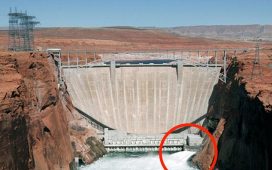An international campaign takes its battle to outlaw “killer robots” to the UN this week with a new ally – a “peace robot”.
Created by an inventor from the BBC programme Robot Wars, the droid, known as David Wreckham, has been recruited to deliver a message to world leaders in New York on Monday.
The robot will drop a letter to UN diplomats demanding that robots not guided by human remote control which could accidentally start wars or cause mass atrocities should be outlawed by the same type of international treaty that bans chemical weapons.
Unlike drones, which are controlled by military teams often thousands of miles away from where they are deployed, critics say that autonomous killer robots have the potential to do disastrous things they were not originally programmed for.
Wreckham will also visit the Manhattan headquarters of hi-tech corporations, calling on them to desist from developing technologies for autonomous weapons.
Ray Tait built the robot out of old saucepans, the motor for an electric wheelchair and a soap dish for a mouth back in 2003.
“It has been in retirement in my garage up in Suffolk for years,” he said as he prepared to fly out to New York with a delegation from the Campaign to Stop Killer Robots for their Monday meeting with global leaders.
“Wreckham was never built as a fighting robot and was meant to do other things, like play football at the Olympics for Robots on a pilot programme called Techno Games.
“They only made the pilot programmes and then the show was cancelled because of cuts at the BBC. So poor old Wreckham went into the garage and looked like he’d never get out of it ever again.”
However, a call from Tait’s friend Noel Sharkey, an emeritus professor of artificial intelligence and robotics at the University of Sheffield and a prominent campaigner against killer robots, resurrected Wreckham.
“Noel asked me if his campaign group could use the robot as a kind of mascot for the campaign, to represent the good side of robots and what they can do for humanity. I agreed instantly, as I entirely support the aims of the campaign,” said Tait.
“The capacity for autonomous machines designed to kill to go completely out of control is massive. Even human remote-controlled machines like drones do strange things you don’t expect. I have seen my drone behave oddly and go wrong when I was flying it near pylons. It had gone out of control. But this could be much worse with an autonomous weapon or “killer robot” because there is no one who can press a button with an automatic kill-switch to destroy it if it gets out of control.”
Clare Conboy, the communications director for the Campaign to Stop Killer Robots, said they had recruited Wreckham to “show that not all robots are going to be as friendly as he is”.
Conboy said 26 heads of state and 21 Nobel peace prize laureates have backed their campaign to have killer robots banned in international law.
During his trip to New York, Wreckham will also visit Times Square alongside a delegation including the UN under-secretary general and high representative for disarmament, Izumi Nakimitsu, Nobel peace prize laureate Jody Williams, Sharkey, tech worker Liz O’ Sullivan, and youth campaigner Mariana Sanz.
In contrast to military AI killing machines, Tait described his android as “the peace robot fighting for a cause I believe in”.
As for his invention’s name, he added: “Yes, he is named after David Beckham, because I loved watching him play football. Wreckham wasn’t too bad a player on that programme either, so the name was obvious.”














